
Greenhouse Effect, Global Warming, Carbon Sequestration
Subscribe to Never Miss an Important Update! Assured Discounts on New Products!
Must Join PMF IAS Telegram Channel & PMF IAS History Telegram Channel
Climate Change
- Climate change means a change of climate which is attributed directly or indirectly to human activity that alters the composition of the global atmosphere and which is in addition to natural climate variability observed over comparable time periods (100 years).
- Climate change is usually measured in major shifts in temperature, rainfall, snow, and wind patterns lasting decades or more.
- Humans are creating climate change by burning large amounts of fossil fuels (coal, oil, natural gas), deforestation (when forests are cut down or burned, they can no longer store carbon, and the carbon is released to the atmosphere).
Greenhouse effect and Global Warming
- A greenhouse is a structure whose roof and walls are made chiefly of transparent material, such as glass, in which plants requiring regulated climatic conditions are grown.
- In a greenhouse, the incident solar radiation (the visible and adjacent portions of the infrared and ultraviolet ranges of the spectrum) passes through the glass roof and walls and is absorbed by the floor, earth, and contents, which become warmer and re-emit the energy as longer-wavelength infrared radiation (heat radiation).
- Glass and other materials used for greenhouse walls do not transmit infrared radiation, so the infrared cannot escape via radiative transfer.
- As the structure is not open to the atmosphere, heat also cannot escape via convection, so the temperature inside the greenhouse rises. This is known as the ‘greenhouse effect’.
Importance of Natural Greenhouse Effect
- The green-house effect is a natural phenomenon and has been occurring for millions of years on the earth.
- Life on the earth has been possible because of this natural greenhouse effect which is due to water vapour and small particles of water present in the atmosphere.
- Together, these produce more than 95 percent of total greenhouse warming.
- Average global temperatures are maintained at about 15°C due to natural greenhouse effect.
- Without this phenomenon, average global temperatures might have been around –17°C and at such low temperature life would not be able to exist.
Greenhouse Gases (GHGs)
- Atmospheric gases like carbon dioxide, methane, nitrous oxide (N2O), water vapour, and chlorofluorocarbons are capable of trapping the out-going infrared radiation from the earth’s surface thereby causing greenhouse effect.
- Hence these gases are known as greenhouse gases and the heating effect is known as greenhouse effect.
Oxides of Nitrogen with general formula NOx – NO, NO2 – Nitrogen oxide, Nitrogen dioxide etc. are global cooling gasses while Nitrous oxide (N2O) is a greenhouse gas.
- If greenhouse gases are not checked, by the turn of the century the temperature may rise by 5°C.
- Scientists believe that this rise in temperature will lead to deleterious changes in the environment and resulting in odd climatic changes (e.g. increased incidence of El Nino), thus leading to increased melting of polar ice caps as well as of other places like the Himalayan snow caps.
Cryosphere: The cryosphere is the frozen water part of the Earth water system. Polar regions, snow caps of high mountain ranges are all part of cryosphere.
- Over many years, this will result in a rise in sea level that can submerge many coastal areas and lead to loss of coastal areas and ecosystems like swamps and marshes (most important ecosystems from the point of ecological services), etc.
| Gas | Sources and Causes |
| Carbon dioxide (CO2) | Burning of fossil fuels, deforestation |
| Chlorofluorocarbons (CFCs) | Refrigeration, solvents, insulation foams, aero propellants, industrial and commercial uses |
| Methane (CH4) | Growing paddy, excreta of cattle and other livestock, termites, burning of fossil fuel, wood, landfills, wetlands, fertilizer factories. |
| Nitrogen oxides (N2O) | Burning of fossil fuels, fertilizers; burning of wood and crop residue. |
| Carbon Monoxide (CO) | Iron ore smelting, burning of fossil fuels, burning e-waste. |
Carbon dioxide
- Carbon dioxide is meteorologically a very important gas as it is transparent to the incoming solar radiation but opaque to the outgoing terrestrial radiation.
- It absorbs a part of terrestrial radiation and reflects back some part of it towards the earth’s surface. It is largely responsible for the greenhouse effect.
- Its concentration is greater close to the earth’s surface as it is denser than air.
Ozone
- Ozone is another important greenhouse gas. But it is in very small proportions at the surface.
- Most of it is confined to the stratosphere where it absorbs the harmful UV radiation.
- At ground level, pollutants like NO2 react with volatile organic compounds in the presence of sunlight to produce ozone (tropospheric ozone).
Water vapour
- Water vapour is also a variable gas in the atmosphere, which decreases with altitude.
- Water vapour also decreases from the equator towards the poles.
- In the warm and wet tropics, it may account for four per cent of the air by volume, while in the dry and cold areas of desert and polar regions, it may be less than one per cent of the air.
- One unique feature about this greenhouse gas is that it absorbs both incoming (a part of incoming) and outgoing solar radiation.
Methane
- Methane is the most important greenhouse gas after carbon dioxide.
- It is produced from decomposition of animal wastes and biological matter.
- The emission of this gas can be restricted by using animal wastes and biological matter to produce gobar gas (methane).
Nitrous Oxide (N2O)
- N2O or Nitrous Oxide is a greenhouse gas.
- NO and NO2 (nitric oxide or nitrogen oxide and nitrogen dioxide) emissions cause global cooling through the formation of (OH) radicals that destroy methane molecules, countering the effect of GHGs.
Carbon Monoxide
- Carbon monoxide is a short-lived greenhouse gas (it is less dense than air).
- It has an indirect radiative forcing effect by elevating concentrations of methane and tropospheric ozone through chemical reactions with other atmospheric constituents (e.g., the hydroxyl radical, OH.) that would otherwise destroy them.
- Through natural processes in the atmosphere, it is eventually oxidized to carbon dioxide.
Fluorinated gases
Chlorofluorocarbons (CFCs)
- CFCs were phased out via the Montreal Protocol due to their part in ozone depletion (explained in Geography > Climatology > Polar Vortex).
- This anthropogenic compound is also a greenhouse gas, with a much higher potential to enhance the greenhouse effect than CO2.
Hydrofluorocarbons
- Hydrofluorocarbons are used as refrigerants, aerosol propellants, solvents, and fire retardants.
- These chemicals were developed as a replacement for chlorofluorocarbons (CFCs).
- Unfortunately, HFCs are potent greenhouse gases with long atmospheric lifetimes.
Perfluorocarbons
- Perfluorocarbons are compounds produced as a by-product in aluminium production and the manufacturing of semiconductors.
- Like HFCs, PFCs generally have long atmospheric lifetimes and high global warming potential.
Sulphur hexafluoride
- Sulphur hexafluoride is also a greenhouse gas.
- Sulphur hexafluoride is used in magnesium processing and semiconductor manufacturing, as well as a tracer gas for leak detection.
- Sulphur hexafluoride is used in electrical transmission equipment, including circuit breakers.
Black Carbon or Soot
- Black carbon (BC) is a solid particle or aerosol (though not a gas) that contributes to warming of the atmosphere. Black carbon, commonly known as soot.
- Soot is a form of particulate air pollutant, produced from incomplete combustion.
- Black carbon warms the earth by absorbing heat in the atmosphere and by reducing albedo (the ability to reflect sunlight) when deposited on snow and ice.
- BC is the strongest absorber of sunlight and heats the air directly.
- In addition, it darkens snow packs and glaciers through deposition and leads to melting of ice and snow.
- Regionally, BC disrupts cloudiness and monsoon rainfall.
- Black carbon stays in the atmosphere for only several days to weeks.
- Thus, the effects of BC on the atmospheric warming and glacier retreat disappear within months of reducing emissions.
Brown Carbon
- Brown carbon is a ubiquitous and unidentified component of organic aerosol.
- Biomass burning (possibly domestic wood burning) is shown to be a major source of brown carbon
- Brown carbon is generally referred for greenhouse gases and black carbon for particles resulting from impure combustion, such as soot and dust.
Q. The increasing amount of carbon dioxide in the air is slowly raising the temperature of the atmosphere, because it absorbs
- the water vapour of the air and retains its heat.
- the ultraviolet part of the solar radiation.
- all the solar radiations.
- the infrared part of the solar radiation
Among GHGs, only water vapor has the ability to absorb both incoming (UV) and outgoing (infrared) radiation.
Answer: d) the infrared part of the solar radiation (outgoing radiation).
GHG Protocol
Q4. What is ‘Greenhouse Gas Protocol’? (2016)
Answer: a) |
Global Warming Potential (GWP) & Lifetime of Green House Gases
| Gas | GWP (100-year) | Lifetime (years) |
| Carbon dioxide | 1 | 50-200 |
| Methane | 21 | 12 |
| Nitrous oxide | 310 | 120 |
| Hydrofluorocarbons (HFCs) | 140 -11,700 | 1-270 |
| Perfluorocarbons (PFCs) | 6,500-9,200 | 800-50,000 |
| Sulphur hexafluoride (SF6) | 23,900 | 3,200 |
Global Warming – Impacts
Melting of the ice caps
- Melting of the ice caps and glaciers will lead to rise in sea level.
- Thermal expansion also contributes to sea level rise.
- Fertile agricultural lands on the coast will be submerged and saline water intrusions will degrade the neighbouring land. Ground water in such regions will become useless.
- Populous cities lying on the coasts will be submerged under the sea.
- Flooding in Himalayas and Ganga plains in wet season and drought in dry season will severely affect the country.
- As a result of thawing of snow, the amount of arable land in high-latitude region is likely to increase by reduction of the amount of frozen lands.
- At the same time arable land along the coast lines are bound to be reduced as a result of rising sea level and saline water inundations.
Extreme Climatic Events
- Increased likelihood of extreme events such as heat wave, flooding, hurricanes, etc. will offset all the economic advancements made.
- Changes in rainfall patterns (E.g. 2015 Chennai floods, 2018 Kerala floods) will severely impact agriculture.
Environmental Degradation
- Reduced hydroelectric power generation due to abnormal behaviour of glaciers will further increase dependence on fossil fuels.
- Widespread vanishing of animal populations due to habitat loss will add more species to the ‘threatened’ and ‘extinct’ list.
Rising Health Related Issues
- Spread of diseases (like malaria, etc.) in tropics will put more pressure on the health care sector.
- It is anticipated that there will be an increase in the number of deaths due to greater frequency and severity of heat waves and other extreme weather events.
- Lack of freshwater during droughts and contamination of freshwater supplies during floods compromise hygiene, thus increasing rates diseases like cholera, diarrhoea etc.
Biodiversity Loss
- Loss of Plankton due to warming of seas will adversely affects marine food chain.
- Bleaching of Coral Reefs (rain forests of the ocean) will cause great loss of marine biodiversity.
- Rising temperature would increase fertilizer requirement for the same production targets and result in higher GHG emissions, ammonia volatilization and cost of crop production.
- Rising temperatures will further affect the physical, chemical and biological properties of fresh water lakes and rivers, with adverse impacts on many individual fresh water species.
No Food Security
- Climate Change affects crops by impacting irrigation, insolation as well as the prevalence of pests.
- Increased frequencies of droughts, floods, storms and cyclones are likely to increase agricultural production variability.
- Moderate warming (increase of 1 to 3°C in mean temperature) is expected to benefit crop yields in temperate regions, while in lower latitudes the crops will take a hit.
- However, the natural calamities due to global warming can offset the benefits in temperature regions.
- In coastal areas, sea level rise will exacerbate water resource constraints due to increased salinization of groundwater supplies.
Deterioration of Carbon sinks
- High latitude forests store more carbon than tropical rainforests.
- One third of the world’s soil-bound carbon is in taiga and tundra areas.
- When the permafrost melts due to global warming, it releases carbon in the form of carbon dioxide and methane.
- In the 1970s the tundra was a carbon sink, but today, it is a carbon source, all because of global warming. (global warming leads to more global warming).
Sea Level Change
- Sea level change means the fluctuations in the mean sea level over a considerably long period of time.
Processes that cause Change in Sea Level
- Eustatic changes occur when the volume of sea water changes due to factors such as
- global warming and melting of ice sheets (rise in sea level) or ice ages (fall in sea level) and
- changes in the volume of mid-oceanic ridges.
- Tectonic changes occur due to a change in the level of land.
- Isostatic changes take place due to addition or removal of load: during ice ages, landmass subsided due to the load exerted by the glacial ice. On the other hand, landmasses rise as the glacial ice is removed.
- Epeirogenic movement occurs due to broad scale tilting of continents which may result in the rise of one part of the continent even as the other part may subside causing an apparent rise in sea level.
- Orogenic movement (mountain building) results in the formation of lofty mountains and an apparent fall in sea level.
Importance of understanding Sea Level Changes
- It provides key evidences regarding climate change in the past.
- It helps in estimating the rates of tectonic upliftment in the past geological periods.
- To assess the suitability of coastal locations for industrial and agricultural development.
- To protect low-lying countries by building coastal dykes and embankments.
- The task of mapping of areas likely to be affected by storm surges and periodic flooding becomes possible only if we know the likely areas to be affected by future sea level rise.
- By identifying the areas of possible submergence in the near future it becomes possible to set up tidal power generation plants in suitable locations.
Changes in Global Sea Level
Short-Term
- Short-term changes occur during a year.
- Commonly, seasonal variations of 5-6 cm in sea level are observed in a year.
Short-term sea level change may be due to a complex interaction of the following factors:
- Marine water density: Temperature and salinity control the density of sea water. Low temperature and high salinity produce high density of sea water and lower sea level.
- Atmospheric pressure: Low pressure results in higher local sea level and vice versa. E.g. Storm surge.
- Velocity of ocean currents: Fast-flowing ocean currents when taking a curved path cause a rise in sea level on their outer fringes.
- Generally, a difference of 18 cm in sea level is observed between the two sides of a fast-flowing current.
- Ice formation and fall in sea level: During winter the ocean water trapped in the icecaps of the northern and the southern hemispheres leads to a fall in sea level.
- Piling up of water along windward coasts: A local rise of sea level occurs in the coastal region as water is driven towards the coasts by an air mass, for example, the sea level rises in south and east Asia during the monsoon months due to landward movement of the air mass.
The twentieth century has observed short-term global sea level rise due to the following factors.
- Global warming in the last century due to anthropogenic activities has resulted in thermal expansion of ocean water. So, the sea level has risen by about 10 to 15 cm in the past 100 years.
- Melting of ice-sheets in the Antarctica by about 3 per cent of its total volume of ice has, to some extent, contributed to global sea level rise.
- In the last century, about 15 per cent of the total volume of the Greenland ice cap melted.
- Besides these areas of ice-melt, other glaciers are also estimated to have contributed about 48 per cent of the global sea level rise.
Long-Term
- Global sea level changes which exceed 100 m are possible only if the major ice-sheets melt or there are substantial changes in the volume of the world’s mid-oceanic ridge.
Impact of Sea Level Fall
- A drop in sea level causes the death of coral reefs as the continental shelves on which they are formed are left dry. So, fresh coral reefs emerge along the fringe of dead corals.
- In places of shallow continental shelves, the fall in sea level leads to greater aridity in the continental hinterland due to reduced surface runoff.
- A fall in sea level in temperate and high latitude regions causes extension of ice caps and glacial tongues onto the continental shelves.
Impact of Possible Rise in Sea Level
- Ice melt in the Antarctica may prove to be dangerous in the near future if the temperature of the atmosphere continues to increase.
- A vast segment of the populated land, viz., the low-lying densely populated coastal areas, will be submerged. Even the small islands will be wiped out.
- An estimated global population of about one billion will be affected by rise in sea levels.
- Immense damage may be caused to the coastal structures like ports, industrial establishments, etc.
- As a result of the rise in sea level, almost 33 per cent of the world’s crop lands could be submerged (coastal plains and deltas are made up of very fertile soils).
- Accelerated coastal erosion may cause damage to and destruction of beaches, coastal dunes and bars.
- As a consequence, a vast section of the coastal land will remain unprotected against the direct attack of sea waves.
- Groundwater resources of the coastal regions will be severely affected by salinization due to marine water intrusion.
- The ecosystem will suffer heavy damages as the deltas, coral atolls and reefs will be destroyed. New coral reefs on the outer fringe of the dead corals will be formed.
- As a result of rise in sea level, the mouths of drainage basins will undergo submergence. This will lead to a readjustment of the long-profiles of the rivers, which are likely to show a rise.
- Islands are the worst affected by the recent rise of sea level. Some of the affected islands are the Carteret Islands, located on the north-east of Papua New Guinea in the Pacific Ocean, and Tuvalu Islands, about 1000 km north of Fiji in the South Pacific.
To check the phenomenon of sea level rise that the ‘Oceans and Coastal Areas Programme Activity Centre’ was set up in 1987 under the aegis of the United Nations Environment Programme (UNEP) to identify the countries facing maximum risk of submergence.
Reducing Carbon in the Atmosphere to fight Climate Change
- Clean coal technology, Carbon capture and storage Carbon Sink and Carbon Sequestration.
Clean coal technology to reduce CO2 in atmosphere
- Half of the world’s electricity is generated by burning coal.
- Coal will remain a dominant energy source for years to come.
- CO2 and CO (carbon monoxide) are the major greenhouse gas which are released during burning of coal.
- Along with the above gases, nitrogen oxides (destroys ozone) and sulphur oxides (acid rains) are also released.
- Clean coal technology seeks to reduce harsh environmental effects by using multiple technologies to clean coal and contain its emissions.
- Some clean coal technologies purify the coal before it burns.
- One type of coal preparation, coal washing, removes unwanted minerals by mixing crushed coal with a liquid and allowing the impurities to separate and settle.
- Other systems control the coal burn to minimize emissions of sulphur dioxide, nitrogen oxides and particulates.
- Electrostatic precipitators remove particulates by charging particles with an electrical field and then capturing them on collection plates.
- Gasification avoids burning coal altogether. With gasification, steam and hot pressurized air or oxygen combine with coal in a reaction that forces carbon molecules apart.
- The resulting syngas, a mixture of carbon monoxide and hydrogen, is then cleaned and burned in a gas turbine to make electricity.
- Wet scrubbers, or flue gas desulfurization systems, remove sulphur dioxide, a major cause of acid rain, by spraying flue gas with limestone and water.
- Low-NOx (nitrogen oxides) burners reduce the creation of nitrogen oxides, a cause of ground-level ozone, by restricting oxygen and manipulating the combustion process.
India’s coal
- Coal mined in India is a poor quality coal (India’s coal is not Carboniferous Coal. It is Gondwana coal) with less carbon, high ash (hard to dispose) and high moisture content (more gases; less fuel efficiency) .
- To improve efficiency and reduce adverse effects, India should do away with its present sub-critical coal power plants and build more super-critical and ultra-super-critical ones (15-20% increase in efficiency).
- Should employ clean coal technology.
Carbon capture and storage
- ‘Carbon capture and storage’ catches and sequesters (hide) carbon dioxide (CO2) from stationary sources like power plants.
- Capture: Flue-gas separation removes CO2 and condenses it into a concentrated CO2 stream.
- After capture, secure containers sequester the collected CO2 to prevent or stall its re-entry into the atmosphere.
- The two storage options are geologic and oceanic (must hide the CO2 until peak emissions subside hundreds of years from now).
Geologic storage involves injecting CO2 into the earth.
- Depleted oil or gas fields and deep saline aquifers safely store CO2 while coal seams absorb it.
- Ocean storage, a technology still in its early stages, involves injecting liquid CO2 into waters 500 to 3,000 meters deep, where it dissolves under pressure.
- However, this method would slightly decrease pH and potentially harm marine habitats.
In the context of mitigating the impending global warming due to anthropogenic emissions of carbon dioxide, which of the following can be the potential sites for carbon sequestration?
- Abandoned and uneconomic coal seams
- Depleted oil and gas reservoirs
- Subterranean deep saline formations
Select the correct answer using the code given below:
- 1 and 2 only
- 3 only
- 1 and 3 only
- 1, 2 and 3
- From figure (below) it is clear that abandoned coal seems, depleted oil and gas reservoirs can be used for carbon sequestration.
Answer: d) all
Carbon Sink and Carbon Sequestration
- A carbon sink is a natural or artificial reservoir that accumulates and stores some carbon-containing chemical compound for an indefinite period.
- The process by which carbon sinks remove carbon dioxide (CO2) from the atmosphere is known as carbon sequestration.
Carbon Sink vs Carbon Source
- A carbon sink is anything that absorbs more carbon than that it releases, whilst a carbon source is anything that releases more carbon than is absorbs.
- Forests, soils, oceans and the atmosphere all store carbon and this carbon moves between them in a continuous cycle.
- This constant movement of carbon means that forests act as sources or sinks at different times.
Carbon Dioxide Fertilization
Carbon Dioxide Fertilization is increasing carbon sink on land
Q. Which of the following statements best describes “carbon fertilization”? (2018)
|
Carbon sequestration
- Carbon sequestration is the process of capture and long-term storage of atmospheric carbon dioxide.
- It has been proposed as a way to slow the atmospheric and marine accumulation of greenhouse gases.
- Carbon dioxide is naturally captured from the atmosphere through biological, chemical, or physical processes.
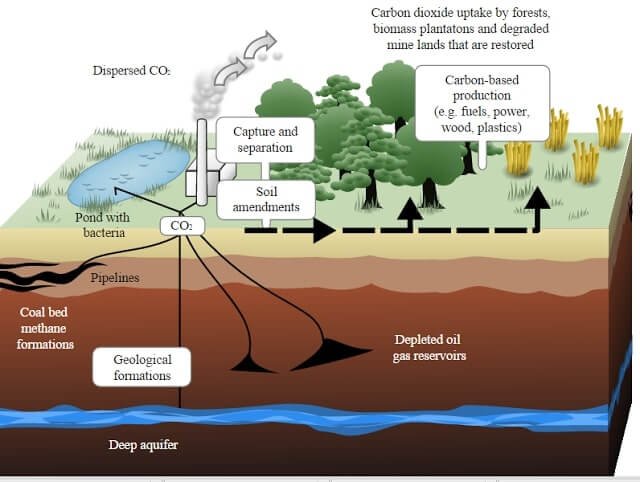
Forests as carbon Sinks
- Forests are carbon stores, and they are carbon dioxide sinks when they are increasing in density or area.
- Trees absorb CO2 during photosynthesis thereby converting atmospheric CO2 into biomass.
- When this biomass is buried the carbon is trapped forming a carbon sink.
- When the carbon sink is exposed the biomass decomposes adding methane to the atmosphere and when the biomass is used as fuel (coal and petroleum) it releases CO2 back into the atmosphere (carbon source).
- Ocean is also a very important carbo sink. Most of the carbon is trapped in the ocean and if a small fraction of this carbon is released the consequences will be disastrous.
- In Canada’s boreal forests as much as 80% of the total carbon is stored in the soils as dead organic matter.
- Tropical forests absorb about 18% of all carbon dioxide added by fossil fuels.
- In the context of climate change, the most important carbon stores are the natural fossil fuel deposits.
- But when humans burn coal, oil and natural gas, they turn fossil carbon stores into atmospheric carbon.
- This release of carbon from fossil fuel has caused greenhouse gas (GHG) concentrations in the atmosphere to soar to levels more than 30 per cent higher than at the beginning of the industrial revolution.
- Because of this increase in atmospheric carbon, a lot of emphasis and hope has been put into the ability of trees, other plants and the soil to temporarily sink the carbon that fossil fuel burning releases into the atmosphere.
- Indeed, the Kyoto Protocol, the international communities’ main instrument for halting global warming suggests that the absorption of carbon dioxide by trees and the soil is just as valid a means to achieve emission reduction commitments as cutting carbon dioxide emissions from fossil fuels.
Q. The scientific view is that the increase in global temperature should not exceed 2 °C above pre-industrial level. If the global temperature increases beyond 3°C above the pre-industrial level, what can be its possible impact/impacts on the world?
- Terrestrial biosphere tends toward a net carbon source
- Widespread coral mortality will occur.
- All the global wetlands will permanently disappear.
- Cultivation of cereals will not be possible anywhere in the world.
Select the correct answer using the code given below.
- 1 only
- 1 and 2 only
- 2, 3 and 4 only
- 1, 2, 3 and 4
Explanation:
- Taiga and temperate forests act as an important carbon sink. Global warming by 3 °C will turn these forests into carbon source.
- Corals are very sensitive to temperature changes. 3 °C rise in global temperature will lead to widespread coral mortality.
- 3° C rise in global temperature will lead to submergence of many low lying coastal wetlands due to rise in sea levels. Inland wetlands like Keoladeo Ghana National Park will not be affected.
- It has been estimated that a sea-level rise of approximately 2.3 metres (7.5 ft) for each degree Celsius of temperature ca occur within the next 2,000 years. (http://goo.gl/LH3RMl)
- Cultivation of cereals in tropics will take a hit. But in temperate regions their production increases in the short run.
Answer: b) 1 and 2 only




![PMF IAS Environment for UPSC 2022-23 [paperback] PMF IAS [Nov 30, 2021]…](https://pmfias.b-cdn.net/wp-content/uploads/2024/04/pmfiasenvironmentforupsc2022-23paperbackpmfiasnov302021.jpg)

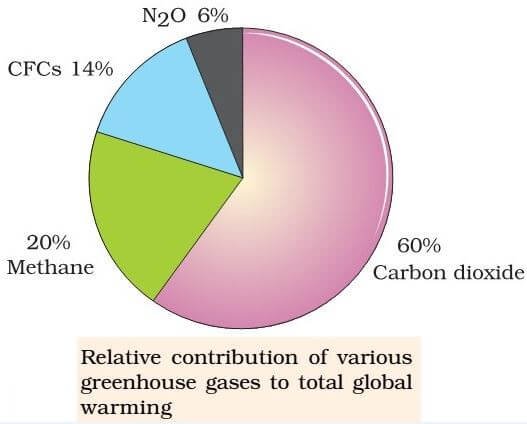
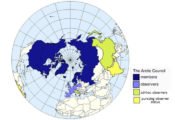
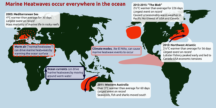
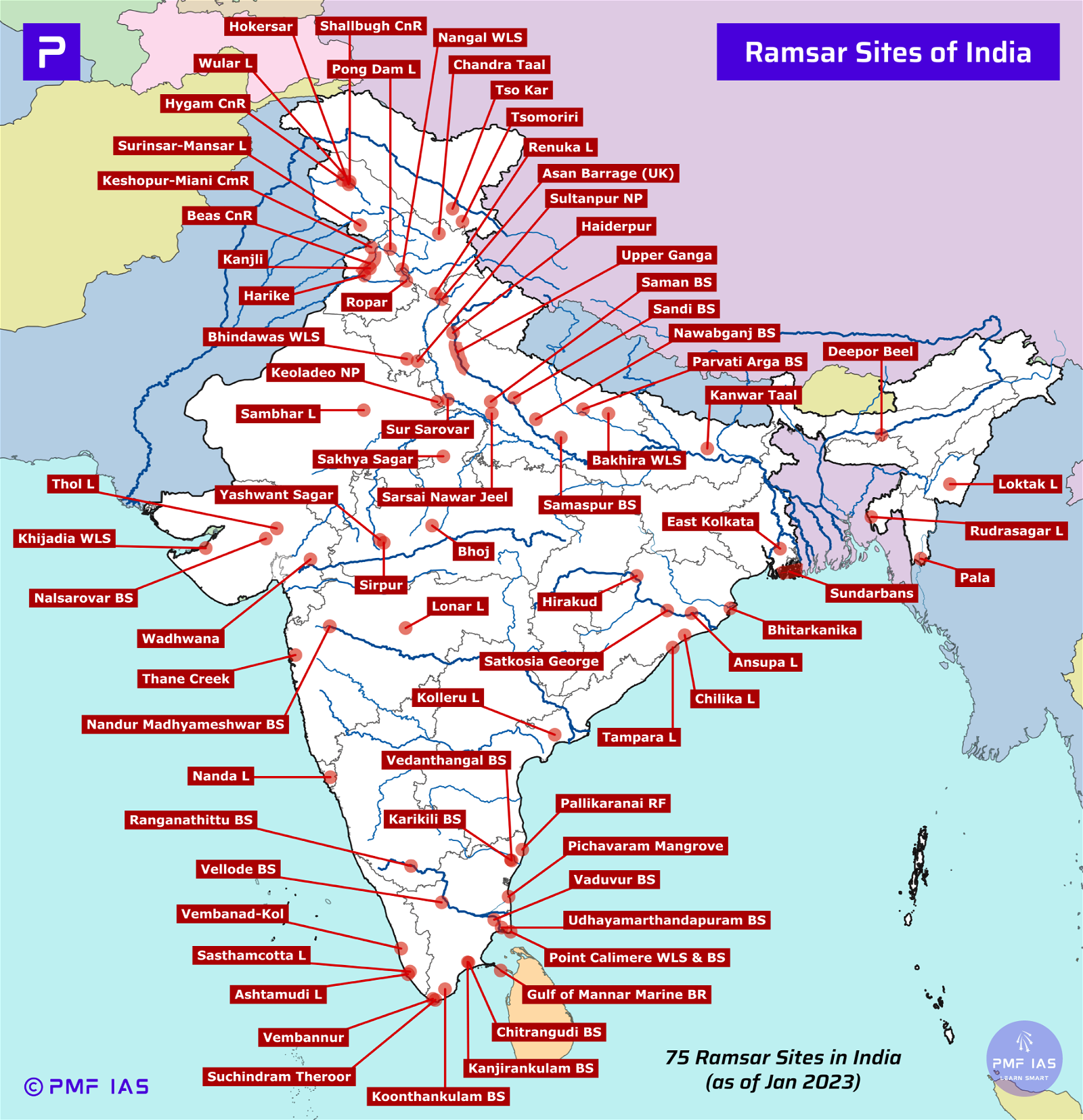


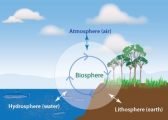






Ozone can also absorb incoming radiations. As it can absorb UV rays then why it can absorb incoming solar radiation??.
This information is very important to me as a student who is interested in geophysics